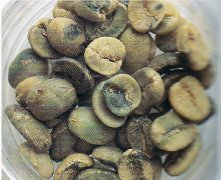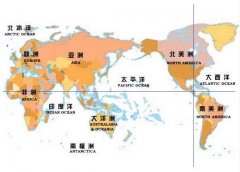Fine Coffee Learn Coffee Green beans are classified into different types according to time
Coffee fruits are processed by wet and dry methods to become coffee beans (Raw beans/Green beans).

The main components of raw beans are: carbohydrates, about 49%;
moisture, approximately 12 per cent;
Protein. about 11%;
Chlorogenic acid, approximately 7.6%
Alkaloids and trace elements, about 0.4%.
According to the length of time, raw beans can be specifically divided into: when the season beans (Current Crop), that is, just harvested raw beans; new beans (New Crop), that is, the first year of raw beans; old beans (Old Crop), that is, stored for too long raw beans; aged beans (Aged Bean), different from old beans, its storage method is unique: wrapped in endocarp, stored in the origin of high and cool warehouse, and often turned. After baking, aged beans taste acid qualitative change weak, alcohol degree becomes high, texture becomes thick, aged heavy, can be combined with new beans when blending, so that acid balance. In addition, after baking, the aged beans should be placed for 3 days before extraction and drinking, so that their thick flavor can be reflected.
In addition, compared with old beans, new beans are more difficult to bake because of their high water content and difficult heat transfer. After baking, the new beans feel lively, have natural flower fragrance, high-quality sour, high moisture content, rich chlorogenic acid, relatively bright and strong taste; the old beans feel calm, high alcohol and consistency, low moisture content, slightly swollen volume, soft taste.
With the increase of time, the internal moisture of raw beans gradually decreases, and the color of raw beans will gradually change from dark green to blue to white and yellow; the smell of fresh fruit or grass will gradually weaken; the vitality will decrease. These can be used as a basis for identifying the freshness of raw beans.
Important Notice :
前街咖啡 FrontStreet Coffee has moved to new addredd:
FrontStreet Coffee Address: 315,Donghua East Road,GuangZhou
Tel:020 38364473
- Prev

Fine coffee what are the defective beans in coffee beans?
Next, I would like to introduce several kinds of defective beans. Moldy beans: because of incomplete drying, or damp in the process of transportation and storage, cyan and white molds grow, which sometimes make the beans stick together. If these moldy beans are not removed, they will produce moldy smell. Dead beans: beans with abnormal results. The color is not easy to change because of baking, so it is easy to distinguish. Wind
- Next

Honduran coffee, the producer of boutique coffee beans in northern Central America.
Honduras: special highland coffee flavor and taste characteristics: good flavor, rich and mellow, suitable for mixed drinking. Honduras is located in the north of Central America, facing the Caribbean Sea to the north, the Gulf of Fonseca in the Pacific Ocean to the south, Nicaragua and El Salvador to the east and south, and Guatemala to the west, mostly mountains and plateaus. It has a tropical climate, mild temperature, abundant rainfall, and is a coffee producer.
Related
- Guji coffee producing area of Guji, Ethiopia: Humbela, Shakiso, Wulaga
- What is the most expensive variety of Qiloso in BOP multi-variety group?
- How to store the coffee beans bought home?
- Why are Yemeni coffee beans so rare now?
- Ethiopian Sidamo all Red Fruit Sun Sun Santa Vini Coffee beans
- SOE is mostly sour? What does it mean? Is it a single bean? what's the difference between it and Italian blending?
- Is Italian coffee beans suitable for making hand-brewed coffee?
- How to choose coffee beans when making cold coffee? What kind of coffee beans are suitable for making cold coffee?
- Just entered the pit to make coffee, what kind of coffee beans should be chosen?
- Can only Japan buy real Blue Mountain Coffee? What are authentic Jamaican Blue Mountain coffee beans?

